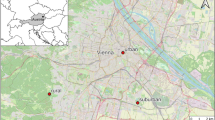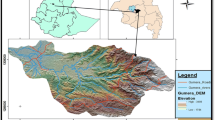Abstract
This paper discusses soils in green recreational areas of Volgograd urban landscapes on the example of Sasha Filippov Public Garden. The soil cover in the public garden is represented by typical (Urbic Technosol), replanted (Urbic Technosol (Mollic)), and technogenic (Urbic Technosols (Hyperartefactic)) urbostratozems, replantozems (Phaeozem (Prototechnic)), and urbostratozems on buried chestnut soils. Sealed urbostratozems (Ekranic Technosols) occur under buildings and road surfaces. The presence of buried horizons indicates that the initial soil cover in this area was represented by chestnut soils (Haplic Kastanozems (Loamic)). The average thickness of urbic horizons (UR) is 95 cm; the average thickness of recultivating layers (RAT) is 50 cm. The soils of the public garden are diverse in terms of their chemical and physical properties. The soil carbon content in the urbic and recultivating horizons varies from 0.11 to 2.46%. Chemical analysis of the urbic and filling horizons showed that the content of readily soluble salts and carbonates is low (0.11 and 1%, respectively). In the RAT layers and anthropogenic UR horizons, the average density values vary in the range of 1.43–1.46 g/cm3. The average densities of buried horizons are as follows: 1.58 g/cm3 for BMK, 1.62 g/cm3 for B, and 1.53 g/cm3 for BCA, which is higher than the average density of native chestnut soils. The average density of the calcareous parent rock (Cca) is 1.38 g/cm3. The results provide insight into the soil genesis in urban recreational areas in connection with the anthropogenic transformation of natural chestnut soils in the dry-steppe natural zone.


Similar content being viewed by others
REFERENCES
Amrein, D., Rusterholz, H.-P., and Baur, B., Disturbance of suburban Fagus forests by recreational activities: effects on soil characteristics, above-ground vegetation and seed bank, Appl. Veg. Sci., 2005, vol. 8, pp. 175–182.
Bezuglova, O.S., Tagiverdiev, S.S., and Gorbov, S.N., Physical properties of urban soils in Rostov agglomeration, Eurasian Soil Sci., 2018, vol. 51, no. 9, pp. 1105–1110.
Charzyński, P., Bednarek, R., Hudańska, P., and Świtoniak, M., Issues related to classification of garden soils from the urban area of Toruń, Poland, Soil Sci. Plant Nutr., 2018, vol. 64, no. 2, pp. 132–137.
Dvornikov, Y.A., Vasenev, V.I., Romzaykina, O.N., Grigorieva, V.E., Dolgikh, A.V., Korneykova, M.V., Litvinov, Y.A., Gorbov, S.N., and Gosse, D.D., Projecting the urbanization effect on soil organic carbon stocks in polar and steppe areas of European Russia by remote sensing, Geoderma, 2021, vol. 399, art. ID 115039.
Eremchenko, O.Z., Shestakov, I.E., and Moskvina, N.V., Pochvy i tekhnogennye poverkhnostnye obrazovaniya urbanizirovannykh territorii Permskogo Prikam’ya (Soils and Technogenic Surface Formations of Urban Territories of Perm Area of Kama Region), Perm: Perm. Gos. Nats. Issled. Univ., 2016.
Gordienko, O.A., Determination of soil and ground sealing in functional zones of Volgograd based on remote sensing data, Byull. Pochv. Inst. im. V.V. Dokuchaeva, 2021, no. 107, pp. 116–138.
Gordienko, O.A., Manaenkov, I.V., Kholodenko, A.V., and Ivantsova, E.A., Mapping and assessment of sealing rate of soils in the city of Volgograd, Eurasian Soil Sci., 2019, vol. 52, no. 11, pp. 1439–1446.
Guidelines for Soil Description, Rome: UN Food Agric. Org., 2006.
Hamberg, L., The effects of habitat edges and trampling intensity on vegetation in urban forests, PhD Thesis, Helsinki: Univ. of Helsinki, 2009, pp. 32.
Hladký, J., Radziemska, M., Klim, M., Koudelkov, Z., Bal, L., and Va, M., Assessment of phytotoxicity, environmental and health risks of historical urban park soils Galiova, Chemosphere, 2019, vol. 220, pp. 678–686.
IUSS Working Group WRB, World Reference Base for Soil Resources 2014, Update 2015, International Soil Classification System for Naming Soils and Creating Legends for Soil Maps, World Soil Resources Reports No. 106, Rome: UN Food Agric. Org., 2015.
Jaroszuk-Sierocińska, M. and Słowińska-Jurkiewicz, A., Physical status of soils of Park Ludowy in Lublin, Acta Agrophys., 2018, vol. 25, no. 2, pp. 213–225.
Matinyan, N.N., Bakhmatova, K.A., Gorbunova, V.S., and Sheshukova, A.A., Soils of the Pavlovsk Park (Saint Petersburg), Eurasian Soil Sci., 2019, vol. 52, no. 11, pp. 1311–1320.
Murata, T., Nobuo, K., Uoi, N., and Watanabe, M., Soils in historical urban parks, in Anthropogenic Soils in Japan, Singapore: Springer-Verlag, 2019, pp. 39–57.
Musielok, D.M., Stolarczyk, M., Szczechowska, K., and Wątły, M., Rates of anthropogenic transformation of soils in the Botanical Garden of Jagiellonian University in Kraków (Poland), Catena, 2018, vol. 170, pp. 272–282.
Nadtochii, I.V. and Okolelova, A.A., Analysis of recreational landscapes in the southern part of Volgograd, Izv. Penz. Gos. Pedagog. Univ. im. V.G. Belinskogo, 2007, no. 7, pp. 296–298.
Paltseva, A., Cheng, Z., Egendorf, S.P., and Groffman, P.M., Remediation of an urban garden with elevated levels of soil contamination, Sci. Total Environ., 2020, vol. 722, art. ID 137965.
Polevoi opredelitel’ pochv Rossii (Field Guide for Identification of Russian Soils), Moscow: Pochv. Inst. im. V.V. Dokuchaeva, 2008.
Prokof’eva, T.V. and Poputnikov, V.O., Anthropogenic transformation of soils in the Pokrovskoe-Streshnevo Park (Moscow) and adjacent residential areas, Eurasian Soil Sci., 2010, vol. 43, no. 6, pp. 701–711.
Prokof’eva, T.V., Gerasimova, M.I., Bezuglova, O.S., Bakhmatova, K.A., Gol’eva, A.A., Gorbov, S.N., Zharikova, E.A., Matinyan, N.N., Nakvasina, E.N., and Sivtseva, N.E., Inclusion of soils and soil-like bodies of urban territories into the Russian soil classification system, Eurasian Soil Sci., 2014, vol. 47, no. 10, pp. 959–967.
Prokof’eva, T.V., Kiryushin, A.V., and Shishkov, V.A., The importance of dust material in urban soil formation: the experience on study of two young technosols on dust depositions, J. Soils Sediments, 2017, vol. 17, pp. 515–524.
Shevchenko, A.A., Recreational space of the region: theoretical approaches in scientific research, Sots.-Gumanit. Znaniya, 2015, no. 9, pp. 237–243.
SP 42.13330.2016. Gradostroitel’stvo. Planirovka i zastroika gorodskikh i sel’skikh poselenii (SP 42.13330.2016. Urban Planning. Planning and Development of Urban and Rural Settlements), Moscow, 2016.
Stroganova, M.N. and Rappoport, A.V., Specific features of anthropogenic soils in botanical gardens of metropolises in the southern taiga subzone, Eurasian Soil Sci., 2005, vol. 38, no. 9, pp. 966–972.
Tikhonova, A.A., Polovinkina, Y.S., and Gordienko, O.A., Features of the monitoring organization of heavy metals in the soil cover of the urban environment, Proc. IV Int. Sci.-Pract. Conf. “Anthropogenic Transformation of Geospace: Nature, Economy, Society,” Dordrecht: Atlantis, 2020, pp. 286–291.
van Reeuwijk, L.P., Procedures for Soil Analysis, ISRIC Tech. Pap., no. 9, 6th ed., Wageningen: Int. Soil Ref. Inf. Centre, 2002.
Wang, W., Lai, Y., Ma, Y., Liu, Z., Wang, S., and Hong, C., Heavy metal contamination of urban topsoil in a petrochemical industrial city in Xinjiang, China, J. Arid Land, 2016, vol. 8, pp. 871–880.
Zharikova, E.A., The main properties of soils in forests and parks of Vladivostok, Vestn. Buryat. Gos. S-kh. Akad. im. V.R. Filippova, 2012, no. 1 (26), pp. 40–46.
Funding
This study was supported by the Russian Foundation for Basic Research, project no. 20-34-90 129 (Soils in Recreational Areas of Volgograd: Diversity, Properties, and Environmental Functions).
Author information
Authors and Affiliations
Corresponding author
Ethics declarations
Conflict of interest. The author declares that he has no conflict of interest.
Statement on the welfare of humans or animals. This article does not contain any studies involving humans or animals performed by the author.
Additional information
Translated by L. Emeliyanov
Rights and permissions
About this article
Cite this article
Gordienko, O.A. Technopedogenesis and Its Effect on Morphological and Chemical Soil Properties in Recreational Areas. The Case of Sasha Filippov Public Garden. Arid Ecosyst 12, 225–232 (2022). https://doi.org/10.1134/S2079096122020044
Received:
Revised:
Accepted:
Published:
Issue Date:
DOI: https://doi.org/10.1134/S2079096122020044




